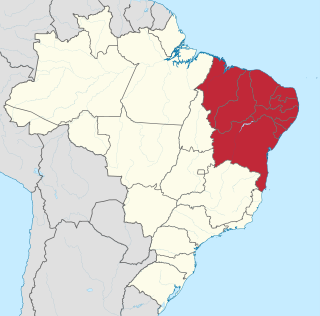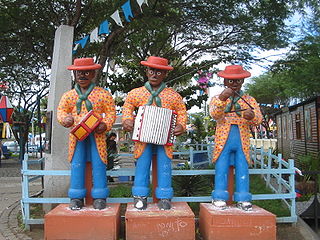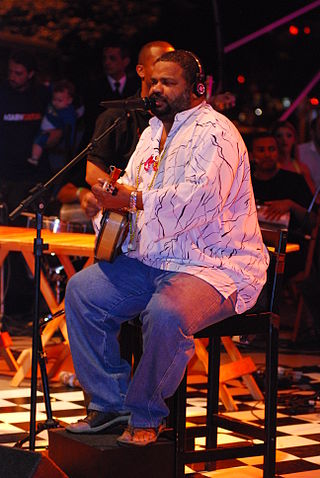
Samba is a name or prefix used for several rhythmic variants, such as samba urbano carioca, samba de roda, recognized as part of the Intangible Cultural Heritage of Humanity by UNESCO, amongst many other forms of samba, mostly originated in the Rio de Janeiro and Bahia states.

Esporte Clube Bahia is a Brazilian professional football club, based in Salvador, capital city of the Brazilian state of Bahia. The club competes in the Campeonato Baiano, Bahia's state league, and the Campeonato Brasileiro Série A, highest division of Brazilian football league system.

The music of Brazil encompasses various regional musical styles influenced by European, American, African and Amerindian forms. Brazilian music developed some unique and original styles such as forró, repente, coco de roda, axé, sertanejo, samba, bossa nova, MPB, gaucho music, pagode, tropicália, choro, maracatu, embolada, frevo, brega, modinha and Brazilian versions of foreign musical styles, such as rock, pop music, soul, hip-hop, disco music, country music, ambient, industrial and psychedelic music, rap, classical music, fado, and gospel.

Bahia is one of the 26 states of Brazil, located in the Northeast Region of the country. It is the fourth-largest Brazilian state by population and the 5th-largest by area. Bahia's capital is the city of Salvador, on a spit of land separating the Bay of All Saints from the Atlantic. Once a stronghold of supporters of direct rule of Brazil by the Portuguese monarchy, and dominated by agricultural, slaving, and ranching interests, Bahia is now a predominantly working-class industrial and agricultural state. The state is home to 7% of the Brazilian population and produces 4.2% of the country's GDP.

The culture of Brazil has been shaped by the amalgamation of diverse indigenous cultures, and the cultural fusion that took place among Indigenous communities, Portuguese colonizers, and Africans, primarily during the Brazilian colonial period. In the late 19th and early 20th centuries, Brazil received a significant number of immigrants, primarily of Portuguese, Italian, Spanish, and German origin, which along with smaller numbers of Austrians, Arabs, Japanese, Poles, Ukrainians, Russians, Greeks, Chinese, and Koreans gave a relevant contribution to the formation of regional cultures in Brazil, and thus contributed to its current existence as a plural and racially diverse society.

A quilombo ; from the Kimbundu word kilombo, lit. 'war camp') is a Brazilian hinterland settlement founded by people of African origin, and others sometimes called Carabali. Most of the inhabitants of quilombos, called quilombolas, were maroons, a term for escaped slaves.

Luiz Gonzaga do Nascimento was a Brazilian singer, songwriter, musician and poet and one of the most influential figures of Brazilian popular music in the twentieth century. He has been credited with having presented the rich universe of Northeastern musical genres to all of Brazil, having popularized the musical genre baião and has been called a "revolutionary" by Antônio Carlos Jobim. According to Caetano Veloso, he was the first significant cultural event with mass appeal in Brazil. Luiz Gonzaga received the Shell prize for Brazilian Popular Music in 1984 and was only the fourth artist to receive this prize after Pixinguinha, Antônio Carlos Jobim and Dorival Caymmi. The Luiz Gonzaga Dam was named in his honor.

The Northeast Region of Brazil is one of the five official and political regions of the country according to the Brazilian Institute of Geography and Statistics. Of Brazil's twenty-six states, it comprises nine: Maranhão, Piauí, Ceará, Rio Grande do Norte, Paraíba, Pernambuco, Alagoas, Sergipe and Bahia, along with the Fernando de Noronha archipelago.
Baião is a Northeastern Brazilian music genre and dance style based on a syncopated duple meter rhythm, based around the pulse of the zabumba, a flat, double-headed bass drum played with a mallet in one hand and a stick in the other, each striking the opposite head of the drum for alternating high and low notes, frequently accompanied by an accordion and a triangle pattern. The baião rhythm is integral to the genres of forró, repente and coco. It is mostly associated with the state of Pernambuco. Baião was popularized via radio in the 1940s, reaching peak popularity in the 1950s.

The term forró refers to a musical genre, a rhythm, a dance and the event itself where forró music is played and danced. Forró is an important part of the culture of the Northeastern Region of Brazil. It encompasses various dance types as well as a number of different musical genres. Their music genres and dances have gained widespread popularity in all regions of Brazil, especially during the Brazilian June Festivals. Forró has also become increasingly popular all over the world, with a well-established forró scene in Europe.

Bumba Meu Boi is an interactive play celebrated in Brazil. It originated in the 18th century. It is a form of social criticism. Lower-class Brazilians mock and criticize those of higher social status through a comedic folklore story told in song and dance. Though not as well known internationally as Carnival and other Brazilian festivals, it is older and deeply rooted in the culture of Brazil. The tale can vary depending on the region and social setting in which it is practiced. However, its essential theme remains the same, with a focus on the death and resurrection of an ox.

Arlindo Cruz is a Brazilian musician and songwriter, working in the genre of samba and pagode. Cruz took part in the most important formation of Grupo Fundo de Quintal, and is considered one of the most important figures of the pagode movement.
Música sertaneja or sertanejo is a music style that had its origins in the countryside of Brazil in the 1920s. Its contemporary developments made it the most popular genre in the country, particularly throughout the southern, southeastern, and center-western interior. Subgenres include sertanejo raiz, sertanejo romântico, and sertanejo universitário.

The agriculture of Brazil is historically one of the principal bases of Brazil's economy. As of 2024 the country is the second biggest grain exporter in the world, with 19% of the international market share, and the fourth overall grain producer. Brazil is the world's largest exporter of many popular agriculture commodities like coffee, soybeans, organic honey, maize, beef, poultry, cane sugar, açai berry, orange juice, yerba mate, cellulose, tobacco, and the second biggest exporter of pork, cotton, and ethanol. The country also has a significant presence as producer and exporter of rice, wheat, eggs, refined sugar, cocoa, beans, nuts, cassava, and diverse fruits and vegetables.
The 2013 Copa do Nordeste was a football competition held in the Brazilian Northeast, counting as the 10th edition in the history of the Copa do Nordeste. It was played from January 19, with its final on 10 and 17 March, featuring 16 clubs, with Bahia and Pernambuco having three berths each and Ceará, Rio Grande do Norte and Sergipe, Alagoas and Paraíba having two each.

Almir Eduardo Melke Sater is a Brazilian singer-songwriter and actor.

Events in the year 2003 in Brazil.

The Nordestino, also known as Crioulo Nordestino, Mourão, Pé Duro Nordestino or Sertanejo do Nordeste, is a breed of horses native to the Northeast Region of Brazil. The breed is near extinction due to the lack of interest in maintaining it. A stud-book was created and approved in 1987 by the Brazilian government; nevertheless in 2017 the authorization to carry out the genealogical records of the breed was revoked by the Ministry of Agriculture causing the loss of the breed's lines records. It is the first native horse breed of Brazil, and derived from the first horses brought by Portuguese settlers in the sixteenth century. Over time the horses have evolved into a small breed very well-adapted to surviving in the local semi-arid climate of the Northeast Region. Today around 500,000 horses survive in the region pulling horse carts or in cattle work.

Paulistania was a proposal by Joaquim Ribeiro, in his work Folklore dos Bandeirantes, from 1946, to describe what he would call "the living space of the old paulists". It was made up of the states of São Paulo, parts of Paraná, parts of the Triângulo Mineiro, the south of Minas Gerais and Goiás, the states of Mato Grosso do Sul and parts of Mato Grosso, a field of influence and exploration by the bandeirantes.

Vaqueiro sertanejo or vaqueiro da caatinga or vaqueiro nordestino are a traditional people and animal herder who tends cattle on ranches in the sertão of Northeast of Brazil. The first vaqueiros sertanejos emerged in state of Bahia, in the 16th centaury.
















